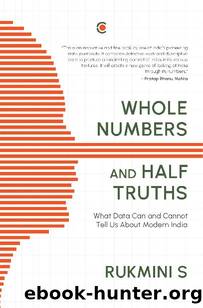Whole Numbers and Half Truths: What Data Can and Cannot Tell Us About Modern India by Rukmini S

Author:Rukmini S [S, Rukmini]
Language: eng
Format: epub
Published: 2021-12-06T00:00:00+00:00
Indiaâs official statistical machinery accepts that there is a divergence. Former chief statistician T.C.A. Anant laid out to me what the NSOâs consumption surveys were missing in some detail. For one, he said, in an unequal country, the bulk of consumption of some commoditiesâthe purchase of laptops or diamond jewellery, for instanceâis going to take place within a very small segment of the population. This presents statisticians with a serious sampling challenge, compounded by the fact that casualty errors (households that are part of the sample, but from which information cannot be collected) are highest among the richest: they are often not at home, they frequently turn away data collectors and they often under-report. Across the economic spectrum, a lot depends on whether the sample selection is accurate, and Indiaâs statistical system acknowledges that there are problems with its urban sample, where the divergence is greatest. Part of the problem is the dynamic nature of Indian urbanisation, to capture which the NSO needs to move to a GIS-mapping system, which is some distance away yet. Finally, household surveys will by definition miss out on all that is consumed outside a household. So a car bought by a private company but given to its director for his personal use will not be declared by him as an asset he owns, yet form part of his consumption. âThis divergence is real, but it is not unique to India. Across the developed and developing world, it ranges from 30 to 70 per cent, and there are methodological and conceptual reasons for this,â Anant told me.
Dr Bhalla believes that the NSO fails at capturing much of Indian consumption, but the bigger problem is that it is getting worse over time. âEvery country has some divergence from national accounts. But in India, the issue is that itâs worsening. If we take the 2017-18 data at face value, the NSSO has gone from capturing just 40 per cent of total consumption as measured by national accounts, to just 37 per cent. Consumption surveys will miss a part of consumption. But how can we have this situation, where your consumption data is missing more than half of all consumption [as measured by national accounts]?â he asked me. (Fig. 6.3)
Most leading economists, however, say that while the NSO could be missing some consumption, and does need improvements, national accounts is not the way to go. Perhaps the most comprehensive assessment of why national accounts data should not be privileged over household survey data came from Angus Deaton in 2005. While consumption surveys might understate spending, national accounts-based estimates overstate spending, particularly in a growing economy. Deaton uses the example of cooking oil, particularly vanaspati (cheap hydrogenated vegetable oil). The national accounts estimate the consumption of vanaspati like this: On one side you have the total production of vanaspati in a year plus net exports. You subtract all the vanaspati that is consumed by government or business, which should give you the final number for private consumption of vanaspati.
Download
This site does not store any files on its server. We only index and link to content provided by other sites. Please contact the content providers to delete copyright contents if any and email us, we'll remove relevant links or contents immediately.
An MBA in a Book by Xander Cansell(213)
Art of The Strategic Side Hustle: Simple Steps to Developing a Passive Income Side Hustle (The Strategic Series) by Hodge Kimberly(173)
Whole Numbers and Half Truths: What Data Can and Cannot Tell Us About Modern India by Rukmini S(146)
The Art of Building Your Resilience and Adaptability by Néstor Gandara(145)
Playing for Time by Jeremy Lewis(137)
Pragmarketism by Arvind Bhandari(135)
Non-Profit Legends for Humanity and Good Citizenship by Moore Hank;(125)
Corporate Chanakya on Leadership by Radhakrishnan Pillai(124)
Under the Skin of the Indian Consumer by David Abikzir(120)
The Sharesies Guide to Investing by Brooke Roberts & Leighton Roberts and Sonya Williams(117)
Case of the Bonsai Manager by R Gopalakrishnan(115)
Crisis Investing for the Rest of the '90s by Douglas Casey(114)
IEC 61636-2-2023 (IEEE Std 1636.2) by IEC(114)
Fine Printing and Private Presses by Roderick Cave(112)
Aesthetic Labour by Warhurst Chris;Nickson Dennis; & Dennis Nickson(110)
Breakpoints by Mike Ashby(109)
Dream Believe Create by Hayley Lewis(108)
IEC 61136-1-1992 scan by Unknown(107)
SMARTS: Are We Hardwired for Success? by CHUCK MARTIN PEG DAWSON AND RICHARD GUARE(92)
